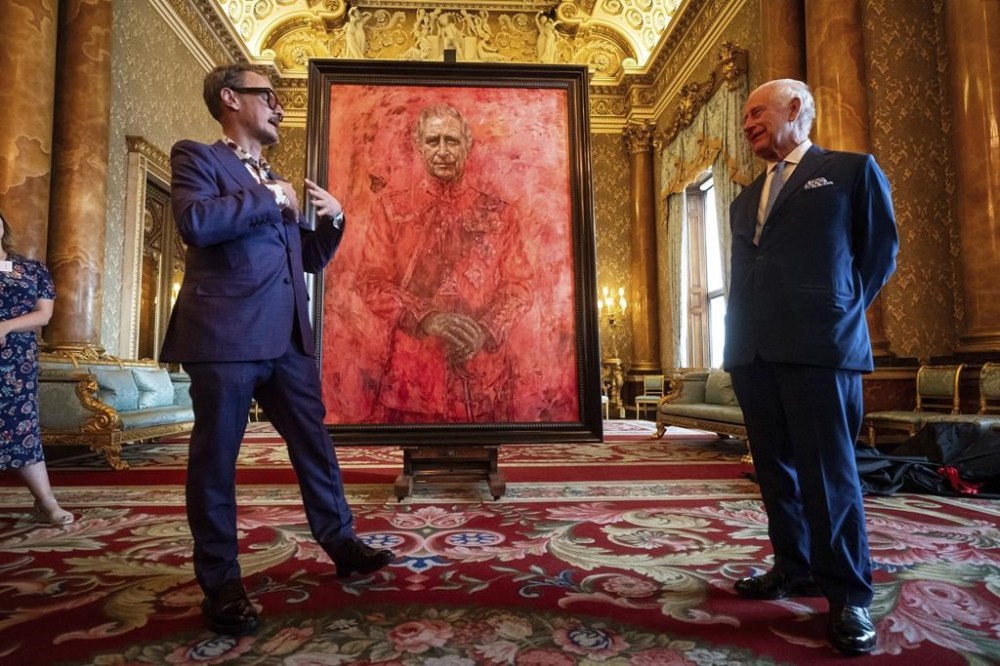King’s portrait doesn’t demand flattery
Blood-red painting agressive, poignant
Advertisement
Read this article for free:
or
Already have an account? Log in here »
To continue reading, please subscribe:
Monthly Digital Subscription
$1 per week for 24 weeks*
- Enjoy unlimited reading on winnipegfreepress.com
- Read the E-Edition, our digital replica newspaper
- Access News Break, our award-winning app
- Play interactive puzzles
*Billed as $4.00 plus GST every four weeks. After 24 weeks, price increases to the regular rate of $19.00 plus GST every four weeks. Offer available to new and qualified returning subscribers only. Cancel any time.
Monthly Digital Subscription
$4.75/week*
- Enjoy unlimited reading on winnipegfreepress.com
- Read the E-Edition, our digital replica newspaper
- Access News Break, our award-winning app
- Play interactive puzzles
*Billed as $19 plus GST every four weeks. Cancel any time.
To continue reading, please subscribe:
Add Winnipeg Free Press access to your Brandon Sun subscription for only
$1 for the first 4 weeks*
*$1 will be added to your next bill. After your 4 weeks access is complete your rate will increase by $0.00 a X percent off the regular rate.
Read unlimited articles for free today:
or
Already have an account? Log in here »
Hey there, time traveller!
This article was published 17/05/2024 (478 days ago), so information in it may no longer be current.
Ever since Louis XIV showed off his well-turned calves to French court painter Hyacinthe Rigaud, the wealthy and powerful have often got their way when it comes to portraiture.
But portraits are almost always more interesting when they record some kind of tussle between artist and subject, some cracks in the official public surface that let some private, human truths get through. By this measure, at least, U.K. artist Jonathan Yeo’s take on King Charles, the first official portrait since his coronation, is a success.
Lurid, unsettling and relentlessly red, the larger-than-life oil-on-canvas work has polarized viewers. Fans of the portrait see it as evidence that the crown can move with the times, that the royals no longer demand smoothed-over idealism but can take their chances with the rougher, more expressive strains of contemporary art.

Haters might counter that maybe monarchs should stop moving with the times and just revert to the so-called “swagger portraits” of the 18th century, all ermine and velvet and unthinking self-assurance.
In this portrait, Charles is dressed in a Welsh Guards uniform, which happens to be a deep scarlet hue. But Yeo has made the decision — creatively bold or passive-aggressively sadistic or just deranged, depending on your viewpoint — to extend that colour into the surrounding space. The result suggests either an enveloping warmth or the sulfurous heat of a blood-drenched hellscape — again, depending on your POV.
(Conspiracy theorists, for instance, are taking this portrait as conclusive “proof” that members of the royal houses of Europe are shape-shifting reptilian satanists. “Lets face it folks they’re not even trying to hide it anymore,” offers one commenter on X.)
The clearest symbolic attribute in the work is a fragile one — the monarch butterfly that flutters at Charles’s shoulder, a verbal nod to royalty but also a visual representation of the king’s commitment to environmentalism. Within the super-saturated colour field, the other trappings of the king’s official status — the braid and ribbon and medals and ceremonial sword — are absorbed into the redness, almost disappearing.
That leaves Charles’s face and hands. Stranded among all that redness, they take on a poignant focus. In their lined, uneven, blotched surfaces, they feel oddly vulnerable, a reminder that royal status cannot protect from the exigencies of the human condition — age, fatigue, illness and uncertainty.
It ought to be noted this isn’t the first British royal portrait to confound viewers. Lucian Freud’s 2002 take on Queen Elizabeth drew both quiet critical praise and some very loud complaints. Daringly small for an official portrait, just nine by six inches, the work is a condensed statement of Freud’s genius for expressing the vulnerability and changeability of flesh, his thick, layered paint recreating its bumps and sags and discolourations in unsparing but oddly tender detail.
Commentators at the time of its unveiling said it made the queen look “like a rugby prop forward with five o’clock shadow” or “one of her corgis.” One critic compared it to “a Richard Nixon joke mask.”
And the queen herself? That ever-tactful sovereign never commented directly on the work, saying only to the painter, “I’ve very much enjoyed watching you mix your colours.”
In 2024, it’s not surprising that Yeo’s portrait has been divisive. It’s ugly. It’s off-putting. It’s aggressively red. It’s been called “a bloodbath.” It’s also been evaluated as “a cheery bit of fakery and razzle dazzle.”
Whatever you might think of the painting, though, it does make clear that His Majesty Charles doesn’t demand flattery, and that’s probably a good quality in a 21st-century king.
alison.gillmor@freepress.mb.ca

Studying at the University of Winnipeg and later Toronto’s York University, Alison Gillmor planned to become an art historian. She ended up catching the journalism bug when she started as visual arts reviewer at the Winnipeg Free Press in 1992.
Our newsroom depends on a growing audience of readers to power our journalism. If you are not a paid reader, please consider becoming a subscriber.
Our newsroom depends on its audience of readers to power our journalism. Thank you for your support.
History
Updated on Friday, May 17, 2024 6:36 AM CDT: Adds photo


